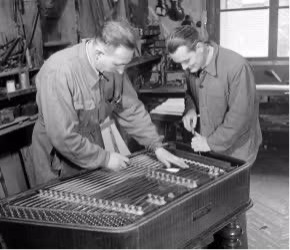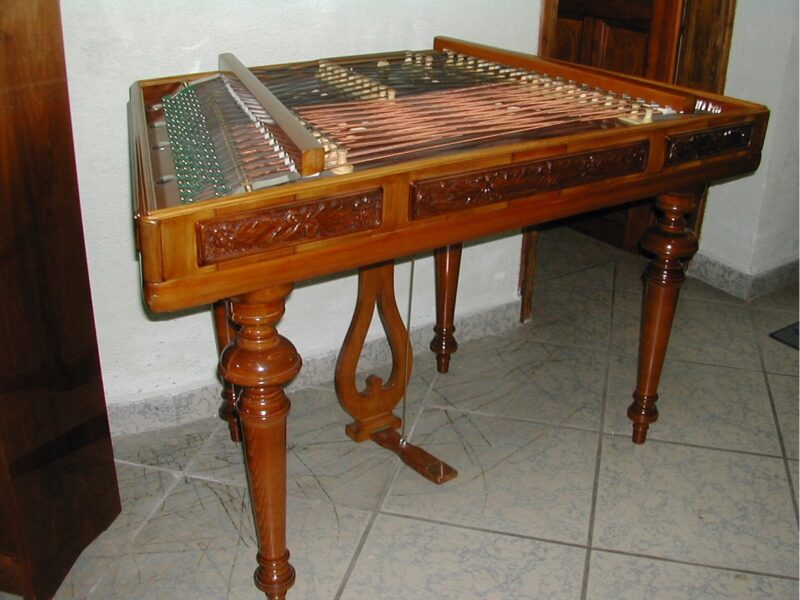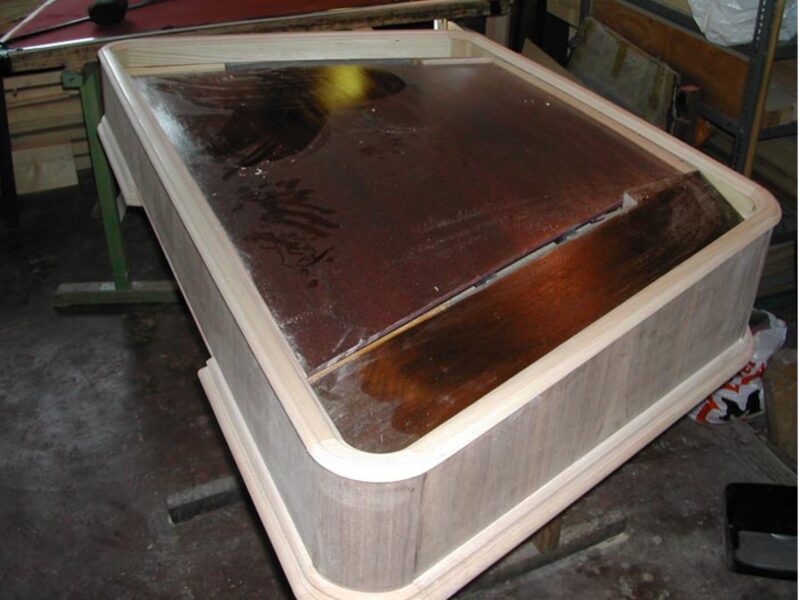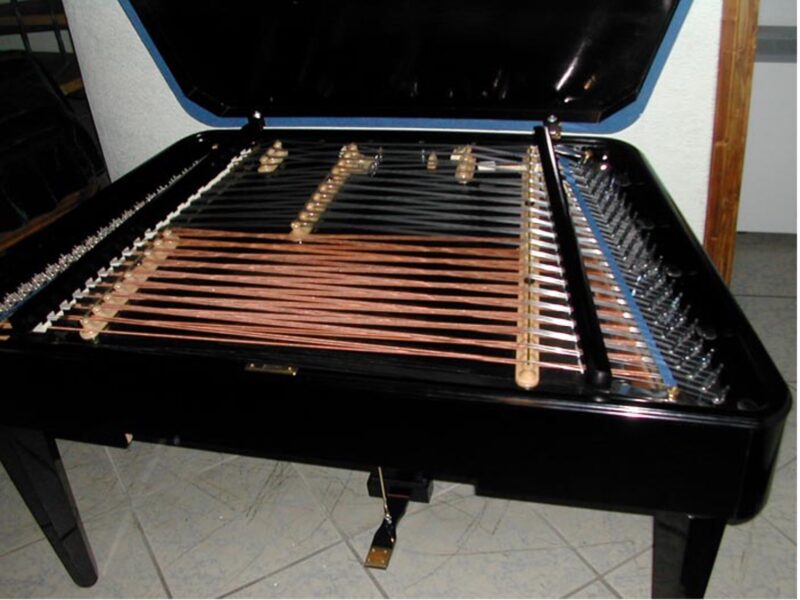
The history of the cimbalom
The concert cimbalom is trapezoid formed, standing on four legs stringed instrument supplied with pedal. The long side of the trapezoid is 150 cm depending on the type, the shorter side is 100 cm, the diameter of the body is 80 cm, the weight is 95 kg. The motherboard is made from pineboard and it is built on a wood or metal structure which is able to resist the contraction force of 12 tons of the string. The player plays the instrument with cymbal beater. The sound range is 4 and a half octav from the C bass sound to 3 lined A. The volume, range and the quality of the sound of the cimbalom made on such way enable it to be included as a solo instrument on concert podiums,and as an accompanying instrument can be an egual partner of any other instrument. Of course it made a long way to reach this level.
The cimbalom is one of the oldest instrument, perhaps it is originated from Assiria, but the most musical instrument history proves it’s origin from Asia. Supposing it’sfirst description is from the 9th century b.C. There are two instruments, existing today, which can be considered as the ancestor of the cimbalom, the ganun and the szantur.
The instrument arrived to Europe during the migration. The cimbalom already appeared in many places in the 16th century. Uniformed tuning and stringing mode did not exist, it was called differently in different languages. It was called hammer dulcimer in English, hackbrett in German, tympanon in French, salterio in Spanish and Italian area, and it was called cimbalom or cimbalka in Middle Europe. It was used in churches as accompanying instrument, or in manor yardsas fun music. These instruments had much less size initially, they had many kinds of form, they can be seen inthe form of triangle, quarilateralin the old descriptions. They were put on table or knee, they were hanged on the neck, they make them sound plucked or with very simple beaters.
In Hungary the first description of the word of cimbalom is from 1533, Benedek Komjath Bible translator wrote it down, but it is mentioned from more sources from this time. Probably the wandering Gypsies spreaded the instrument in our homeland. The cimbalom became more popular in the years of 1800s, the demands against them grew, as the sound range was narrow, it can not be softened, the harmonies are crashed, the player softened the strings with his hand. It needs development.
The story of the Schunda firm, the birth of the cimbalom with pedal
Joseph Schunda performed the first more serious development onthe cimbalom. Schunda was born in Czech Republic, he got to know there with the profession of instrument maker. He moved to Pest upon the invitation of Juul Keresztely, a musical instrument maker in Pest in the years of 1840s. During the revolution in 1848-49 the firm was booming, they got a lot of order from the fighting groups, and during the years of 1850s they supply also a lot of institutions with different musical instruments. After beating down the revolution the ruling Habsburg clerks wanted to push down the Hungarian national feeling, which caused resistance in many people. As a result of it the opera of Ferenc Erkel was born (Bánk bán), it was presented in 1861 in the National Theatre. Mihály Mosonyi, the composer talked Erkel into making the cimbalom sound in one of the most decisive scene. On the first performances Erkel’s son, Sandor made the cimbalom sound. The cimbalom was included on stage for the first time. This insrument is on display also in the Hungarian National Museum.
In 1871 Joseph Schunda left the firm to his younger brother, Joseph Vencel Schunda, who turned all his energy to the development of the music instrument factory from this time. He made contract with expert workers, and supplied the factoriy with machines were appropriate for the age. The cimbalom without pedal made by the firm had a great success, serious demad arose developing the instrument further, and producing it in greater numbers. In 1874 Joseph Vencel Schunda stood up the cimbalom on 4 legs, expanded it’s sound range from D-E bass to E3, and supplied with pedal and dumper system, thereby he stopped the crash of harmonies. He modified totally the external appearance of it, he supplied it with pretty decorated rama and frame. The cimbalom with pedal was born.
The leading artists, Liszt, Erkel, Geza Allaga, Mihaly Mosonyi welcommed the new musical instrument with enormous joy, they predicted it a nice future. Liszt wrote in his letter to Joseph Vencel Schunda: „You grabbed out an ancient musical instrument from lying down from more thousand years, and gave it the ability of salon, orchestra and concert. The Hungarian nation and the Hungarian music literature are obliged to having eternal gratitude towards You. I welcome You in the name of Hungarian music art.” Ferenc Liszt presented the newly developed instrument in the Music Academy in front of numerous high ranked guest. There was a serious demand for expanding the literature of the cimbalom, the composers wrote cimbalom works, cimbalom schools. The renewed cimbalom had a great succes everywhere in home and international intstrument exhibitions also, the cimbalom spreaded and became well known among the highest music circle. The instrument was presented the royal mansions in Europe, the cimbalom appeared in the palace of German emperor, English and Belgian kings and also of numerous ruler. In 1884 the 1000th cimbalom was produced, which was given to the public among solemn frames. By 1891 3000 pieces were made,by the Milleneum celebration the 7000th cimbalom was produced.In 1906 the factory produced the 10000th cimbalom. At this celebration organized to this occasion Franz Joseph also appeared beside several famous public persons. At this time the cimbalom could be found in all countries in Europe, it was made for USA, Australia and Egypt also.
In 1890 a cimbalom department was setup in the National Music Center with the guide of Geza Allaga. Contemporary composers wrote several pieces of music, transcripts to cimbalom.
The cimbalom could show nice results till the fist world war, it became a fashionable and demanded instrument.
After the world war the nimbus of cimbalom lost, because of preferencing the jazz music and spreading the piano. The cimbalom was taking back increasingly. Joseph Vencel Schunda died, his son, Charles took over the guide of the firm. By the years of 1920s the cimbalom was totally out of fashion, the factory passed to make different instruments also, but these undertakings could not save the firm from bankruptcy, which was happened in 1931.
Aladar Racz formed a concert instrument from cimbalom. He was born in 1886 as a member of a famous Gipsy family. He was playing musin in Paris and Geneva from 1910, but he stopped playing entertaining music and started an artistic carrier. He gave his first solo concert in 1926 in Lausanne, after he gave concerts all over Europe. He biult up the classical repertoire of cimbalom. He was the teacher first of the National Music Center, later from 1938 till his death of the College of Music. Thanks to him the cimbalom gained space inthe world of classical music.
The dinasty of Bohák
Beside the Schunda firm the Bohak dinasty had the most famous workshop in Hungary. Lajos Bohak was born in 1870, in 1921, he made himself independent, and he formed his final workshop at 63. Baross street, inthe 8th district. Several innovations and developments can be thanked to Lajos Bohak which were acknowledged also by Schundas.
As during the 1920s the piano began to displace totally the cimbalom from the musical life, Bohak would have liked to stop the process with this that he tried to approach the sound of cimbalom to the sound world of piano. He reached it so that he set free the vibrating close resonant plate, he opened the resonant roof on two sides, so he could build greater sound volume and nicer sound quality in the instrument.He expanded also the sound range, he made the bass part totally chromatic, he expanded further the discant part, he created spreading the bass from C-Cisz –D-Disz –E to A3 concert cimbalom of big orchestra. He renewed the pedal structure also, instead of the heavy weight dumper system used till this time he found out the solution of pedal spring, with it he mute of sound would be easier and more effective. Because of the free resonant the bracing structure of the instrument had to be also reformed, instead of the H iron used till that time he built in more serious iron structure, as well as he transformed the beam, improved the statical structure of the instrument. Thereby the life of the cimbalom significally grew comparing the ones of Schunda. The cimbalom using today is made upon similar construction.
After 1945 the situation of independent masters with small business became very uncertain, which strongly degraded Lajos Bohak ’s health conditionas well, he died in 1952. His son jr Lajos Bohak took over the guide of the workshop. They could continue their independent activity till 1953, then after long persuasion and force jr Lajos Bohak entered the Cooperative of Budapest Instrument Makers. In 1957 the cimbalom workshop moved to the center of the cooperative, to Hajos street in 6th district. Lajos Bohak was retired from here, as the guide of the cimbalom department. Of course it was very important for him to solve the succession, he tried to bring up several young colleagues.
In the years of 70s, 80s the Gipsy music bands were very popular in restaurants in Budapest, it was a strong demand for cimbalom with good sound quality, and bearing serious use. Gabor Frei carried on the profession first, who learned the cimbalom making from Lajos Bohak, but he left the workshop in 1970, and he continued his activity at Capital Craft Company. This company specialized to making large number of instruments, the quality took back a little, that’s why Bohak saw, He had to teach a man, who can represent the same line, as he and his father. At this time they called Istvan Jancso instrument maker from the department of the piano repairing of the cooperative, who entered the cimbalom workshop in 1971, he made his first independent instruments within some years.
Jr Lajos Bohak diedi n 1984. The two masters of the cimbalom are resting in the cemetary in Kerepes street.
The developments of Istvan Jancso
Istvan Jancso performed several serious developments on the cimbalom. Planning the cimbalom with open bottom was the most important. As the cimbalom was used by more and more classical musicians, there was demand for being it’s sound world a little bit different as the cimbalom used so far. The bass register oppressed the discant parts a bit at cimbalom with closed bottom made till that time. The sound of cimbalom with open bottom became more balanced, the new model became popular in the circle of artist playing classical music soon.
The other important innovation of Istvan Jancso was to build in the inner voice recorder. This allowed the dimming of the sounds located in the upper register and was not dimmed till now. There were rudimentary attempts earlier to solve this problem, but Istvan Jancso could use the solutions used at piano repairing, so he could develop the upper sound voice recorder system to a perfect level.
The third serious innovation was changing the thickness of the resonant plate. Till that time the resonant roof was made to the same thickness both in the part of the discant and bass, Istvan Jancso planed the resonant roof to more thinner in the bass part similarly to the piano resonant. With this the sound of bass register became nicer.
Despite of the several innovation and developments the cimbalom made by Istvan Jancso were totally agreed with the cimbalom made earlier by Bohak both in external and internal structure, the so called Kozmosz cimbalom meant the same thing as the cimbalom with the best quality within the circle of musicians and artists (the Instrument Making Cooperative in Hajos street took on the name of Kozmosz Industral Cooprative).
Istvan Jancso worked in the cimbalom workshop in Hajos street from 1971 to 2005, during this time he made about 100 cimbalom, and performed several reparations. The cimbalom made by him can be found in the Hungarian National Opera, in the Hungarian Radio, inthe House of Traditions, in the Hungarian Academy of Music, in several music schools and in different institutes, in Japan, USA, Australia and almost in each country in Eorope. (Somebody mentioned, that once he met a Kozmosz cimbalom in Libanon in a hall of a hotel.) From 1983, he was also active as an justice expert. At the end of the years 1990s the musicians signed more often, that it is difficult to transport the cimbalom because of it’s weight, demand arose for buildig an easier portable little cimbalom. Istvan Jancso made this model, which was a little cimbalom in 53 kilogram- it’s sound world and structure was somilar to Schunda cimbalom.
The recent past and present of cimbalom making, short presentation of cimbalom making
In 2003 the Kozmosz Industrial Cooperative ceased. Opera Piano Room became the successor of the firm, but the cimbalom workshop continued its activity on the same way. Istvan Jancso was retired in 2005, I became his successor.
I entered the Kozmosz Industrial Cooperative in 1991, as a cimbalom maker student beside Istvan Jancso. I finished the Musical Training School of Liszt Ferenc College of Music, I made my firtst independent instrument in 1995. Later I learned the profession of repairing piano. Later I became an outgoing tuner. In 2005 – after Istvan Jancso retiring — we tried to continue the work with the same quality and on the same level.
We build the raw materials with the best quality into the cimbalom made by us.The wood we made the instrument from we buy at the wood yard, we store it under eaves for years, with half year before usingwe take it to drier, so the wood parts built into the cimbalom will not move, crack. We use a lot of kinds of wood with different hardness during the making process. There are raw materials we order from Germany, the pinewood boards we use to making the resonant roof we have got from there for several years. The resonant roof defines the sound quality compromise can not be made when choice the material.
We bring the block wood also from Germany, we make from it the block, where we build the tuner angles and hooks in, these parts keep the strings. The most suitable materials can be built in also in this cases, otherwise the instrument would not keep the tuning. The method of making has hardly changed essentially, we work the planks ahead with carpentry industrial machines, but after the cimbalom making is an absolur handwork. We make the stickings with hot gelatin, as it is the only sticking, which can bear the deformation of instruments, otherwise it is extremely durable. During the making we use a lot of handmade tools, different sized chisels, hand planer, hand saw and several special tools of cimbalom making made by us. The prepared woodmaterials must be composed, summed up, fitted together and tapped into each other, that at the end of work it must make the impact, as if wouldbe made from a single material. Inthe case of cimbalom the most important thing is to build the body of the cimbalom, that it can bear the concration force of 12 tons of strings. For this reason it is important choicing the appropriate materials and the handwork covering all details. Not only the wood stucture keeps the instrument, inside itthere is an iron brace system, which we build in also with the accuracy of 1000 mm.
The surface treatment of halfmade parts we make polishing with hand. We can make a lot of shade according to demands. It is a long work, but different type of lacquerdoes not show well on concert cimbaloms.
When we made the different parts (the bodyand rama of the cimbalom, the resonant roof and other parts), we begin to build up the separate parts. We put together the resonant, install the strings and belonging parts. The strings arrive in coils from Germany, first we cut of them with hand, after we thread the bass strings with machine. We build in the required damping system to the strung cimbalom body. Generally the people who order cimbalom by us, request the instrument with upper damper system. We install the cimbalom rama to the body made on that way, we make the rama in several sort of design an size according to demands. After we put the cimbalom on it’s foot, regulate, tune often and supply it with closable roof.
The artists signed several times, that the cimbalom made by us are excellent in quality, but transporting them means a serious problem for them because of their weight. That’swhy we developed a new type, we took the rama off it, we made the bracing system easier, we made the sound range narrower a litle, so on this way we can make an easier portable cimbalom with a good sound quality and volume, weight of 60 kgand appropriate for concert.
The stories of the past years show, that we can succeed to preserve the position, that you can still meet cimbalom with the most serious level in Budapest. When I took over my master’s degree, Istvan Jancso gave it with the remark:
„Preserve the reputation of the Hungarian cimbalom!”
Bohak wrote in one of his product broschure:
„The sound of the cimbalom expressing each human feeling is the Hungarian song. The cimbalom is a piece of Hungary a little.”
Mor Jokai named the cimbalom as Hungarian Piano.






















